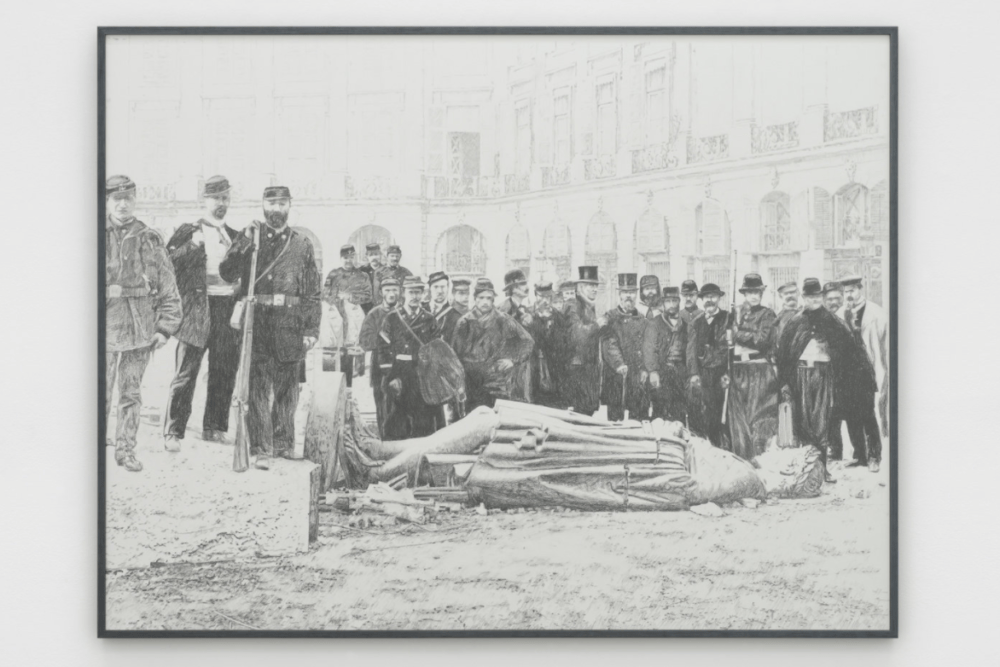What stories do monuments tell? Is there more than one story, more than one point of view? Can monuments be moved from one location and placed in another? Confederate statues taken away from the Kentucky capital go where? How can they be recontextualized? During the summer of 2020, numerous statues and monuments were toppled during political protests for Black Lives Matter. The Mellon Foundation has pledged to spend $250 million over five years on an initiative that will reimagine monuments “in an effort to better reflect the nation’s diversity and highlight buried or marginalized stories.”
The Mellon Foundation’s “Monuments Project” bears a curious relationship to a 2018 body of work by Sam Durant now on view at Blum & Poe. In his exhibition “Iconoclasm,” he presents a recent two channel video projection and six large-scale graphite drawings created in 2018 whose source is historic photographs featuring statues and monuments that have been defaced or are in the process of being toppled. Durant has titled this body of work “Iconoclasm,” which, according to Wikipedia, “is the social belief in the importance of the destruction of icons and other images or monuments, most frequently for religious or political reasons.”

Sam Durant, Paris, 1871, (2018). Graphite on paper. 58″ x 76.” Courtesy of Blum & Poe.
These evocative and beautifully rendered drawings portray certain historical struggles and conflicts over class, race, or religion. Looking at the works chronologically, Durant begins in Utrecht,1572, drawing a reproduction of a photograph showing the altar piece from St. Martin’s Cathedral and focusing on its destroyed faces from an attack during the Protestant Reformation in the 16th century. He then moves to Paris, 1871, an image of the toppled statue of Napoleon from the Column Vendome, destroyed by the Paris Commune. Next is Budapest 1956, in which a massive statue of Joseph Stalin was pulled down by anti-Soviet crowds. Durant depicts the graffitied relic amidst a crowd of onlookers. Fort-de-France,1991 is a drawing of the headless statue of the Empress Josephine in Martinique. She was instrumental in reinstituting slavery in the French colonies less than ten years after it had been banned in 1789. Coincidentally, her statue was completely destroyed by Black Lives protesters in July, 2020. On the ‘Day of Indigenous Resistance’ in Caracas, 2004, protesters pulled down a 30 foot high, 100-year-old statue of Christopher Columbus. In Durant’s drawing, the rope used to dislodge the statue extends across the composition in the moment before it falls to the ground. Mosul, 2015, is an image from an online video showing two ISIS fighters defacing statues from the Mosul Museum in their belief that representations are apostasy.

Sam Durant, Caracas, 2004, (2018.) Graphite on paper. Courtesy of Blum & Poe.
Although Durant’s source material spans time, we regard the drawings in the present. At this moment, it is impossible not to relate these images to the recent destruction of monuments world-wide and think about the reasons why they are under attack. While Durant’s choices of source imagery depict acts of violence, he softens the impact of the destruction by presenting the original photographs (which are easily found on Google) as enlarged graphite drawings with lush tonalities of black and gray. This is not an exercise in the aestheticization of appropriated imagery, as Durant has been drawing and creating sculptures culled from significant moments in history throughout his career, but a way to call attention to the current situation.
In his drawings, Durant represents a single moment in time captured by a photographer at the scene. It comes as a surprise to then see the destruction unfold as it occurs in his latest video, Trope (2020). In this two-channel, twelve-minute piece, he slows down found internet clips of statues being defaced and destroyed and sequences them into loops that meet in the corner as they are projected onto two adjacent walls. The clips play both forward and back simultaneously, becoming an uncanny diptych that is slightly out of sync. At first, it is somewhat of a shock to see the toppled monuments resurrected, but the rise and fall injects a Buster Keaton-like humor into the dramas and calls attention to the absurdity, as well as the passion that goes into pulling down these towering and powerful monuments. Remarking on the destruction of statues and memorials during political protests, Durant states, “We are seeing those impulses acted on around the world today as people who have been traumatized and whose dignity has been assaulted take down symbols of their oppression.” In his current exhibition he memorializes by preserving these resonant symbols of protest.
Sam Durant
“Iconoclasm”
Blum and Poe
October 1 – November 7, 2020


